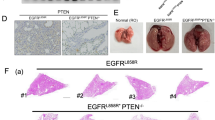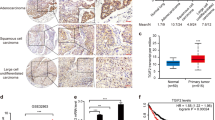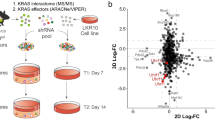Abstract
Lung cancer is a common cancer and the leading cause of cancer-related death worldwide. Aberrant activation of WNT signaling is implicated in lung carcinogenesis. EMX2, a human homologue of the Drosophila empty spiracles gene is a homeodomain-containing transcription factor. The function of EMX2 has been linked to the WNT signaling pathway during embryonic patterning in mice. However, little is known about the role of EMX2 in human tumorigenesis. In this study, we found that EMX2 was dramatically downregulated in lung cancer tissue samples and this downregulation was associated with methylation of the EMX2 promoter. Restoration of EMX2 expression in lung cancer cells lacking endogenous EMX2 expression suppressed cell proliferation and invasive phenotypes, inhibited canonical WNT signaling, and sensitized lung cancer cells to the treatment of the chemo cytotoxic drug cisplatin. On the other hand, knockdown of EMX2 expression in lung cancer cells expressing endogenous EMX2 promoted cell proliferation, invasive phenotypes and canonical WNT signaling. Taken together, our study suggests that EMX2 may have important roles as a novel suppressor in human lung cancer.
This is a preview of subscription content, access via your institution
Access options
Subscribe to this journal
Receive 50 print issues and online access
$259.00 per year
only $5.18 per issue
Buy this article
- Purchase on Springer Link
- Instant access to full article PDF
Prices may be subject to local taxes which are calculated during checkout




Similar content being viewed by others
References
Abate-Shen C . (2002). Deregulated homeobox gene expression in cancer: cause or consequence? Nat Rev Cancer 10: 777–785.
Akiri G, Cherian MM, Vijayakumar S, Liu G, Bafico A, Aaronson SA . (2009). Wnt pathway aberrations including autocrine Wnt activation occur at high frequency in human non-small-cell lung carcinoma. Oncogene 28: 2163–2172.
American Cancer Society. (2008), Cancer facts and figures.
Boersma CJ, Bloemen M, Hendriks JM, van Berkel EA, Olijve W, van Zoelen EJ . (1999). Homeobox proteins as signal transduction intermediates in regulation of NCAM expression by recombinant human bone morphogenetic protein-2 in osteoblast-like cells. Mol Cell Biol Res Commun 2: 117–124.
Clement G, Guilleret I, He B, Yagui-Beltrán A, Lin YC, You L et al. (2008). Epigenetic alteration of the Wnt inhibitory factor-1 promoter occurs early in the carcinogenesis of Barrett's esophagus. Cancer Sci 99: 46–53.
Dalton D, Chadwick R, McGinnis W . (1989). Expression and embryonic function of empty spiracles: a Drosophila homeo box gene with two patterning functions on the anterior-posterior axis of the embryo. Genes Dev 3: 1940–1956.
Donato R . (2001). S100: a multigenic family of calcium-modulated proteins of the EF-hand type with intracellular and extracellular functional roles. Int J Biochem Cell Biol 33: 637–668.
Fackler MJ, McVeigh M, Mehrotra J, Blum MA, Lange J, Lapides A et al. (2004). Quantitative multiplex methylation-specific PCR assay for the detection of promoter hypermethylation in multiple genes in breast cancer. Cancer Res 64: 4442–4452.
Fong KM, Sekido Y, Gazdar AF, Minna JD . (2003). Lung cancer. 9: molecular biology of lung cancer: clinical implications. Thorax 58: 892–900.
Fukui T, Kondo M, Ito G, Maeda O, Sato N, Yoshioka H et al. (2005). Transcriptional silencing of secreted frizzled related protein 1 (SFRP 1) by promoter hypermethylation in non-small-cell lung cancer. Oncogene 24: 6323–6327.
Galli R, Fiocco R, De Filippis L, Muzio L, Gritti A, Mercurio S et al. (2002). Emx2 regulates the proliferation of stem cells of the adult mammalian central nervous system. Development 129: 1633–1644.
Ganesan K, Ivanova T, Wu Y, Rajasegaran V, Wu J, Lee MH et al. (2008). Inhibition of gastric cancer invasion and metastasis by PLA2G2A, a novel beta-catenin/TCF target gene. Cancer Res 68: 4277–4286.
Grote HJ, Schmiemann V, Geddert H, Bocking A, Kappes R, Gabbert HE et al. (2006). Methylation of RAS association domain family protein 1a as a biomarker of lung cancer. Cancer 108: 129–134.
Grote HJ, Schmiemann V, Geddert H, Rohr UP, Kappes R, Gabbert HE et al. (2005). Aberrant promoter methylation of p16(INK4a), RARB2 and SEMA3B in bronchial aspirates from patients with suspected lung cancer. Int J Cancer 116: 720–725.
He B, Lee AY, Dadfarmay S, You L, Xu Z, Reguart N et al. (2005). SFRP4 is silenced by hypermethylation and induces apoptosis in β-catenin-deficient human mesothelioma cells. Cancer Res 65: 743–748.
Heizmann CW, Fritz G, Schafer BW . (2002). S100 proteins: structure, functions and pathology. Front Biosci 7: d1356–d1368.
Huang CL, Liu D, Ishikawa S, Nakashima T, Nakashima N, Yokomise H et al. (2008). Wnt1 overexpression promotes tumour progression in non-small cell lung cancer. Eur J Cancer 44: 2680–2688.
Jemal A, Siegel R, Ward E, Hao Y, Xu J, Murray T et al. (2008). Cancer statistics. CA Cancer J Clin 58: 71–96.
Klaus A, Birchmeier W . (2008). Wnt signaling and its impact on development and cancer. Nat Rev Cancer 8: 387–398.
Ligon KL, Echelard Y, Assimacopoulos S, Danielian PS, Kaing S, Grove EA et al. (2003). Loss of Emx2 function leads to ectopic expression of Wnt1 in the developing telencephalon and cortical dysplasia. Development 130: 2275–2287.
Lind GE, Skotheim RI, Fraga MF, Abeler VM, Esteller M, Lothe RA . (2006). Novel epigenetically deregulated genes in testicular cancer include homeobox genes and SCGB3A1 (HIN-1). J Pathol 210: 441–449.
Marenholz I, Heizmann CW, Fritz G . (2004). S100 proteins in mouse and man: from evolution to function and pathology (including an update of the nomenclature). Biochem Biophys Res Commun 322: 1111–1122.
Mazieres J, He B, You L, Xu Z, Lee AY, Mikami I et al. (2004). Wnt inhibitory factor-1 is silenced by promoter hypermethylation in human lung cancer. Cancer Res 64: 4717–4720.
Nguyen DX, Chiang AC, Zhang XH, Kim JY, Kris MG, Ladanyi M et al. (2009). WNT/TCF signaling through LEF1 and HOXB9 mediates lung adenocarcinoma metastasis. Cell 138: 51–62.
Noonan FC, Goodfellow PJ, Staloch LJ, Mutch DG, Simon TC . (2003). Antisense transcripts at the EMX2 locus in human and mouse. Genomics 81: 58–66.
Noonan FC, Mutch DG, Ann Mallon M, Goodfellow PJ . (2001). Characterization of the homeodomain gene EMX2: sequence conservation, expression analysis, and a search for mutations in endometrial cancers. Genomics 76: 37–44.
Raman V, Tamori A, Vali M, Zeller K, Korz D, Sukumar S . (2000). HOXA5 regulates expression of the progesterone receptor. J Biol Chem 275: 26551–26555.
Raz D, Ray MR, Kim J, He B, Taron M, Skrzypski M et al. (2008). A multi-gene assay is prognostic of survival in patients with early-stage lung adenocarcinoma. Clin Cancer Res 14: 5565–5570.
Samuel S, Naora H . (2005). Homeobox gene expression in cancer: insights from developmental regulation and deregulation. Eur J Cancer 16: 2428–2437.
Stein U, Arlt F, Walther W, Smith J, Waldman T, Harris ED et al. (2006). The metastasis-associated gene S100A4 is a novel target of beta-catenin/T-cell factor signaling in colon cancer. Gastroenterology 131: 1486–1500.
Taylor HS, Fei X . (2005). Emx2 regulates mammalian reproduction by altering endometrial cell proliferation. Mol Endocrinol 19: 2839–2846.
Travis WD . (2002). Pathology of lung cancer. Clin Chest Med 23: 65–81, viii.
Yoshida H, Broaddus R, Cheng W, Xie S, Naora H . (2006). Deregulation of the HOXA10 homeobox gene in endometrial carcinoma: role in epithelial-mesenchymal transition. Cancer Res 2: 889–897.
You L, He B, Xu Z, Uematsu K, Mazieres J, Mikami I et al. (2004). A novel anti-human Wnt-2 monoclonal antibody induces programmed cell death in human non-small-cell lung cancer cells. Oncogene 23: 6170–6174.
Zimmer DB, Wright Sadosky P, Weber DJ . (2003). Molecular mechanisms of S100-target protein interactions. Microsc Res Tech 60: 552–559.
Zochbauer-Muller S, Wistuba II, Minna JD, Gazdar AF . (2000). Fragile histidine triad (FHIT) gene abnormalities in lung cancer. Clin Lung Cancer 2: 141–145.
Acknowledgements
This study was supported by grant from Joan’s Legacy: uniting against Lung Cancer Research Grant, NIH/NCI grant R01CA125030 and the Eileen D Ludwig endowed for Thoracic Oncology Research (to BH); the Bonnie J Addario Lung Cancer Foundation, the Kazan, McClain, Abrams, Fernandez, Lyons, Greenwood, Harley and Oberman Foundation and the Barbara Isackson Lung Cancer Research Fund (DJ); Swedish Cancer Institute (MJ); NIH/NCI grants R01CA130980, R01CA13256 and DOD BCRP Era of Hope Scholar Award (W81XWH-06-1-0416) (to LMC). Microarray profiling was done by the UCSF Shared Microarray Core Facilities. We thank M Roshni Ray for editing this paper.
Author information
Authors and Affiliations
Corresponding author
Ethics declarations
Competing interests
The authors declare no conflict of interest.
Additional information
Supplementary Information accompanies the paper on the Oncogene website
Supplementary information
Rights and permissions
About this article
Cite this article
Okamoto, J., Hirata, T., Chen, Z. et al. EMX2 is epigenetically silenced and suppresses growth in human lung cancer. Oncogene 29, 5969–5975 (2010). https://doi.org/10.1038/onc.2010.330
Received:
Revised:
Accepted:
Published:
Issue Date:
DOI: https://doi.org/10.1038/onc.2010.330
Keywords
This article is cited by
-
Prognostic significance of AP-2α/γ targets as cancer therapeutics
Scientific Reports (2022)
-
Empty spiracles homeobox genes EMX1 and EMX2 regulate WNT pathway activation in sarcomagenesis
Journal of Experimental & Clinical Cancer Research (2021)
-
Regulation of sarcomagenesis by the empty spiracles homeobox genes EMX1 and EMX2
Cell Death & Disease (2021)
-
TCRα rearrangements identify a subgroup of NKL-deregulated adult T-ALLs associated with favorable outcome
Leukemia (2018)
-
ABCB1 and ABCG2 drug transporters are differentially expressed in non-small cell lung cancers (NSCLC) and expression is modified by cisplatin treatment via altered Wnt signaling
Respiratory Research (2017)



